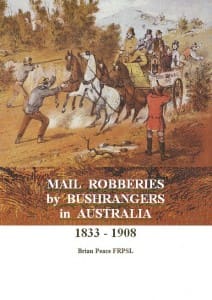MAIL ROBBERIES BY BUSHRANGERS IN AUSTRALIA 1833 – 1908
This is a study of how bushrangers, and their armed attacks on the Mails, impacted the social and economic health of Australia, and of the struggle by the authorities to deal with the issue over several decades. It demonstrates how all layers of society were affected by these attacks, and how trade and commerce with the interior were almost brought to a standstill in certain areas. Extracts from Proceedings in Parliament, Post Office Returns, editorials and letters to editors of newspapers indicate how parliamentarians, the judiciary, the police, successive Colonial Secretaries and Postmasters-General were apparently incapable of solving the problem.
Incensed settlers, tradesmen, merchants, bankers, coach operators and anyone who needed to travel, were constantly writing irate letters to newspapers demanding something be done. There was impassioned lobbying for guards on mail coaches, but Parliament repeatedly refused to sanction the, not inconsiderable, expense. A relatively small number of criminals, generically described as bushrangers, were, for a period, holding a country to ransom.
In the 75-year period from 1833 to 1908, 430 armed attacks on the Mail have been identified. There are no reliable official figures for the number of mail robberies during this period and so contemporary reports in newspapers and Police and Government Gazettes have been examined with over 90,000 references checked. There are comprehensive lists of all attacks on the Mails with the names of the mail carriers and perpetrators, where known. The fate of the mails and references for every incident are included.
As Dr Geoff Kellow, RDP, MAP, FRPSL states in his Foreword: The philatelic consequences of this work will be interesting. Armed now with the dates and locations of every nineteenth century mail robbery, how many covers will be identified from these events? Up till now, there have been only two “robbers” covers known, both from Victoria, and identified by endorsements to indicate the reason for their delay in delivery. The wonderful 1851 “Opened by Robbers” cover, I know, was one of Bill Purves’ favourite philatelic possessions. This book now contains illustrations of two more items which can be associated with robberies on the basis of despatch dates and routes. There must be more to be found…
Perfect bound in A4 format and containing 209 + vii pages with 82 illustrations, 41 in colour, this book gives a fascinating insight into the chaos which followed the regular disruption of mail services and the protracted battle between bushrangers and the authorities. Maps showing the locations of the attacks are included and the only recorded items of 19th Century recovered mail are illustrated.
